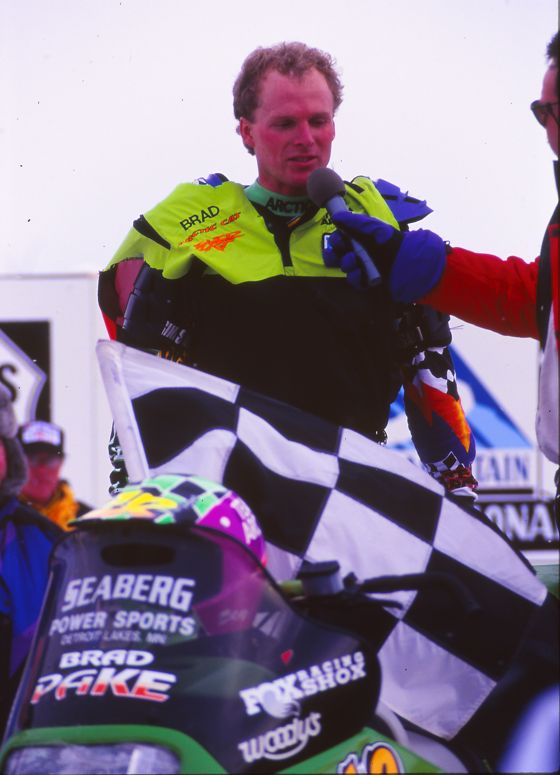
To a fan of snowmobile racing in the 1990s, Brad Pake was synonymous with winning and Team Arctic. Racing aboard the mighty ZRs beginning in 1994, Pake established himself as one of the most talented and formidable terrain racers the sport had ever seen.
In a remarkable four-year stretch that ranks among the all-time greatest, the calm and quiet farmer from Felton, Minn., claimed two I-500 cross-country wins; one ISOC High Point championship; the 1996 Snow Week Racer of the Year award; one FANS championships; wins at nearly every major cross-country event and a pile of snocross wins.
And when he was done, he quietly hung up his helmet and walked away, without any fanfare.
These days he’s a 46-year old husband; father of three (Erika, Maria and Andy); farmer; and budding snowmobile race mechanic. I caught up with him a few weeks ago, when he talked about the glorious days of terrain racing, getting DQ’d, his friendly rivalvry with Kirk Hibbert and whole bunch of cool stuff from his career.
AI: Brad, let’s start with you telling us a little bit about your life now, in 2014. What are you doing these days?
Pake: Whatever Jane tells me to do. (Laughter)
Besides obeying my wife, I’m spending my time farming and raising kids.
We farm corn, soybeans and sugar beats on 2,700 acres. It’s my full-time job, plus my dad and a few others help me in the spring and fall. I’ve been doing this since high school. It started with my grandpa, then my dad and now me.
As for family, Jane and I have three kids: Erika, Maria and Andy. The girls are into volleyball, softball and figure skating, while Andy plays basketball, baseball and football.
The girls quit basketball, so I got a fish house. But now we’re starting to race again with Andy, so I won’t use the fish house much. (Laughter)
AI: You still snowmobile a fair bit… tell me about that.
Pake: I retired from racing after 2001 and didn’t ride much from then until 2008, probably because I was burned out on it and needed a break. Then I got back into it starting with western trips with mountain sleds in 2008. Now kids are old enough to ride so we ride out here.
I still go west 2-3 times a season with some friends. We’ve transitioned away from huge, deep hill climbing and now we’re doing more of the boon docking in the trees. As I get older, I justy can’t do the rock ledges, although it depends on what group I go with. When I’m with Kirk [Hibbert] and Paul Engelstad, it’s valleys and trees, with Kirk trying to get me stuck. With other guys, it’s more meadows.
AI: What snowmobiles do you ride?
Pake: For mountain sleds I have a 2008 M8 with a turbo. I really like that sled, the turbo makes it feel lighter and it’s a really maneuverable sled. I also have a stock 2012 M8. Both machines have 153-in. tracks.
For around here I have a 2009 Crossfire 1000 CFR, the lake racer. I like the CFR 1000 for trails… I’m old school so I like to zip around corners rather than standing up. Plus we have a 2007 F1000, a 2004 F7 Firecat, two Sno Pro 500s and a 2002 Panther 2-up.
I kept three of my race sleds: the 1995 and the 1996 ZR 440 Sno Pros that won the I-500s those years, as well as my 2001 ZR440 race sled. The 1996 I-500 winner is at the Snowmobile Hall of Fame in St. Germain.
AI: You might not have done much riding after you quit racing, but it seems like you never seemed to stray too far away from snowmobile racing. I’ve seen you spectating at various snocross and cross-country races over the years. Have you always kept an interest in racing?
Pake: I didn’t go to too many races the first couple years after retiring, but for the past decade I’ve probably gone to 1-2 a year. Sometimes I think Jane likes going to races more than I do, she always wants to go.
AI: You made a very brief return to cross-country about 10 years ago.
Pake: I was going to come back and race I-500 in 2004. I rode couple hundred miles around here and then did a XC in North Dakota. By that time cross-country had gone from having long 75-mile ditch courses, to multiple laps around a 12-mile course. Well, at the race there was marginal snow, guys were crashing on approaches, with some of them lying in the ditch. And I was terrible. So I pulled the plug and didn’t race the I-500.
I think it’s true that once you race, it never leaves you. But once you leave racing, you lose touch with it. A guy thinks he could run and still be fast, but it’s not true. Even at lake races like Pine Lake, with the smooth ice…I sometimes get the itch to do it again and kid myself that I could run with the top guys, but I know that my corner speed wouldn’t match the fast guys anymore.
But I might throw something in the trailer someday when the kids are older. Just for fun. Someday…
The kids and I started riding dirt bikes a bit last fall. And we’ll probably do more of that next summer. That gets me wanting to ride snowmobiles more. It would be fun to just go and slide around some corners.
AI: That’s a good jumping off point to talk about your racing career. Tell me about how you got started.
Pake: My first race was the 1992 Jeep I-500. Maybe I did a Heartland cross-country race, I don’t remember exactly. At the time I was into 3-wheelers, quads and dirt bikes, but didn’t really follow snowmobile racing.
One day I was at a friend’s party, and someone says, “That’s Matt Knochenmus. His brother won the I-500.”
I was kind of surprised…not because Matt’s brother Nolan had won [in 1987], but because I’d never really thought about the I-500, even though I’d seen the race as a kid when the route came through Felton.
So just seeing Matt at the party…a few of us guys decided we should do the I-500 (laughs). I raced it in 1992 and finished 35th. It was a good experience and I like it, so I was going to get a little more serious the next year.

AI: That next year, the 1993 season, was kind of your breakout year.
Pake: I suppose it was. I remember showing up at Pine Lake for the 1993 season with 96 studs in my track and trail carbides. I had no idea that a lake race meant that you raced on ice, and that you needed 192 sharpened picks and 10-in. sharpened carbides. (Laughter)
Obviously I didn’t do too well there, but I also entered the I-500 again. I had a Polaris Indy…it’s funny, but what I remember most about getting that sled ready for the race was that it needed different handlebars, so I bought some Jack Struthers signature handlebars. I also had Jack revalve the FOX shocks. The night before we left for the race, a buddy and I did some clutching. In the dark. (Laughter)
I look back at that race…the sled was bogging, it didn’t run so good, but I did pretty well…(pause)… I think we do better at things when we don’t know what we’re up against! I had no clue what I was doing, but I didn’t know any better and so it all turned out well in the end.
I don’t remember much from the actual race, but I had one good day. The North Shore trail from Duluth to Grand Marais was a blast, just going wide open and passing people. That year it was a four-day event that started in White Bear Lake, Minn., and finished in Thunder Bay. I was in second overall, just one minute in front of Kirk [Hibbert] on overall time, going into the final day from Grand Marais to Thunder Bay.
I was doing pretty well for most of that day, staying in front of Kirk. At one point I got stuck in some buck brush and, just as I was pulling back onto the route, Kirk caught me. I let him around. As it turned out, he won the race by just a few seconds over Doug Lasher. So whatever tall tales Kirk likes to tell about handing me the win at the ’96 I-500, I can dish it back to him by saying that he would not have won in ’93 if I hadn’t let him around me. (Laughs)
I ended up third overall in 1993. At the time, I didn’t really know what the heck was going on. I didn’t realize the magnitude. I was really just some trail rider having fun. In fact, I almost got kicked out of the race because my crew was late getting through some check point. They’d been out late the night before and were still recovering. (Laughter)
AI: How did you get on Team Arctic for 1994?
Pake: After finishing third in the I-500 the year prior, I honestly thought I’d get a little help from Polaris, maybe a discount on a sled or something, but I didn’t.
I think I called Cat and talked with Joey [Hallstrom, the Team Arctic Race Manager at the time]. I think Kirk must have put in a good word for me because of the I-500… he maybe expected that he was going to pass me earlier than he did (laughs), because Joey helped me with some sleds.
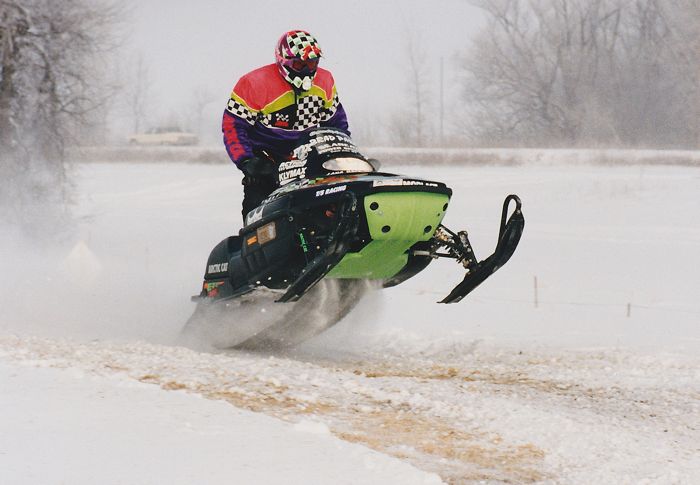
AI: Your career had a pretty steep upward curve, where it seemed like you started winning really early. When and where was your first Pro win?
Pake: That first year on Team Arctic, 1994, I had some decent races but never put it all together. I led after the first day of the I-500 from Thunder Bay to Grand Marais, but burned down on Devil’s Track Lake the next day.
I had good race going in McGregor, but ran out of gas last day. And there was a stop sign penalty. (Laughter) I did well in Lundar (Canada), so I was improving.
My first win didn’t come until the 1995 ISOC Grand I-500 in ISOC [see above photo].
Well, actually my first win was at the TRF Ironman a week before the Grand 500, but I got DQ for having an illegal cylinder, but that’s another story. (Laughs)
To win…(pause)… I knew it was big deal at the time, but it took a lot of years to realize how fortunate I was to win. At the time it happens, you don’t really process it.
That was the year that lack of snow forced us to race around Lake Mille Lacs for two days. I remember being on that lake and the two days of long laps, waiting for a belt to blow. So in a way, what I felt mostly upon winning was just relief, rather than elation, more relief. Plus I felt validated for what happened with the DQ at the Ironman.
I think the Grand 500 was my one and only win that year. Earlier in the season I led the Detroit Lakes race until the last lap or two, but I lost my brakes and Todd Wolff got the win. I was 26 in 1995, which in a way is kind of old.
AI: Let’s go back to the DQ at the 1995 Ironman…what happened?
Pake: That was year the whole fleet of Cat cylinders got ported prior to the start of the race season, because Suzuki didn’t build them to spec or something. So already the competition was mad and hammering on ISOC and probably ISR too.
Making matters worse, our sleds had hard durometer tracks that year. They would chunk out during races [i.e. the tops of the lugs would break off], making studs effectively stick out further. Which of course added fuel to the already simmering fire.
So I won the two-day Ironman 250, which was probably the second most important race behind the I-500 back then. Post-race tech lasted a long time. They were looking at tracks and cylinders.
They DQ’d me for cylinders, but they never said what exactly was wrong with them. And they kept them, so I never got them back.
Probably my cylinders were ground a little too good, and were too perfectly and close to spec. Obviously, once the can of worms opened with Cat having to touch up the ports prior to the season, there was the potential for controversy. We didn’t think our cylinders were over-ported. Roger [Skime] was really upset by the whole situation, he thought we were unfairly disqualified.
It was pretty disappointing. For one, the race paid around $12,000 for the win. But the bigger disappointment was that there was a DQ next to my name. That’s something that sticks in peoples’ minds for a long time.
After that episode, we got our next cylinders inspected prior to the Grand 500.
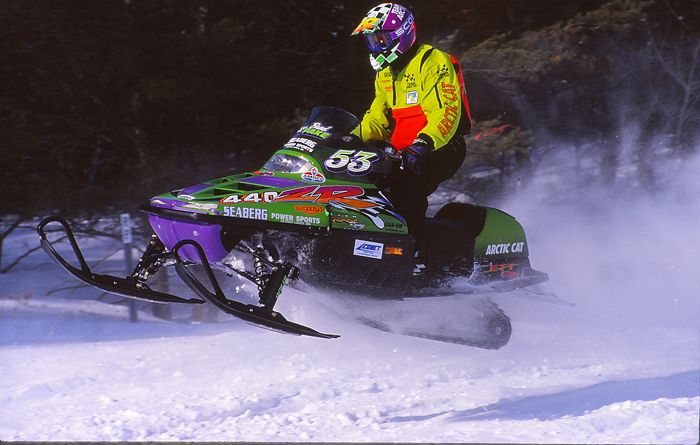
Pake near Bemidji, Minn., during the 1996 I-500, which won for the second consecutive year.
AI: What are some other races during your career that stand out to you now, some 20 years later?
Pake: Hmmm, I think about the first-ever Canterbury race, when the headlights were falling out of all the sleds from the bumps. We were kind of ready for that race, but Toni [Haikonen] was really ready. Our sleds were set up for cross-country, but should have had a snocross set up. We were doubling and maybe even tripling jumps, I think it was the first time for that in snowmobile racing. Toni was smooth and good. I was on my head and hood a few times. It opened my eyes for what we had to do the next year, and on the drive home that weekend I bought a dirt bike because I could see what was coming.
I also think about 1996 as a whole, because the stars aligned for me that year. Arctic Cat came out with what I think was the best sled they ever had. Everything ran great and consistent. It was good for me and I had a great season. I won a class at Duluth. I think I won Canterbury…that was a long one, something like two hours. I lapped up to 3rd or 4th, including Toni. I think we surprised Ski-Doo with that one.
I won Garrison after a great battle with Jeremy Fyle. I won Albertville, although Kirk will tell you that he had to battle trying to get around Corey [Davidson] all day, who apparently was using some creative lines, which prevented Kirk from getting up to and racing with me. (Laughter).
The biggest win in ’96 was my repeat at the I-500. That was a good one…I led every day of it and kept Kirk behind me on the last day.

Pake and Kirk Hibbert finished 1-2 in the 1996 I-500.
AI: Kirk frequently reminisces to me about a couple of racing incidents with you, that race is one of them! Kirk’s version of you winning the ’96 I-500 was that you and Tom [Herfindahl, Pake’s mechanic] saw that Kirk had a short windshield among the parts he brought to the maintenance session prior to the final leg, and that you guys took note and got a short window for your sled. An unforeseen problem with Kirk’s sled took all the available time in his session, so he didn’t have time to put on the shorter windshield. But you did, and on the last leg that extra couple of MPH was the difference between you winning and him getting second. So Kirk claims that he handed you that win on silver platter. (Laughs) Is that true?
Pake: For one thing it’s his fault, because he should never have told me the lower shield is faster. (Laughs)
The last leg of that race went from Bemidji to Roseau. I remember looking behind me, he was about a quarter-mile back, which is really just one mistake away from catching me. Having to race for three hours, trying to win an I-500 with Kirk Hibbert haunting you…that’s about as nerve racking as it gets!
Kirk was something else…he was 10 years older than everyone else when he was at his best. I think he won a snocross at 40. After a race weekend, I always needed to relax on Monday and not ride. Kirk was different. Monday morning after a race, he’d be testing. He was pretty exceptional.
Anyway, those are the races that seem to stick out to me.
AI: What about the Jackson Hillclimbs you competed in?
Pake: Yeah, those were pretty great too. I did them in 1996 and ’97. I’ll tell what: going over the top of Snow King is a pretty amazing experience, and one of the coolest things in my career.
I think I got a second place in 1996. In 1997 we built a ZRT 800 into a long-track hill-climber, and I won the Stock class with it. But I got thrown out for having rail braces on it. That was kind of a weird deal.

AI: What kind of racing did you prefer, cross-country or snocross?
Pake: I liked cross-county ditch races the best. Snocross was fine, but as you know it changed so much from mid- to late-1990s. When the jumps got big, I wasn’t up for that. Prior to that, the bumps weren’t any bigger than what you’d see in a cross-country. What changed it was Canterbury.
I could never get myself to triple jump. You know, like how Jack [Struthers] would never double-jump? I was okay with double jumping, but I didn’t want to triple. Nor did I like when the jump faces got so high that I couldn’t see what guys in front were doing.
Everything just changed so fast. Flagmen hadn’t yet figured it all out… it just wasn’t as safe as I wanted to feel. It’s like the sport progressed too fast and it required a kind of recklessness for a couple years.
In cross-country, you have time to think, which is better for me. Snocross progressed to the point where you didn’t have time to think, you just had to go for it.
AI: Talking about how snocross changed so quickly, it seems like the change was ripe for a motocross guy to come in, which is what happened with Blair Morgan. The sport changed, and Blair was phenomenal, yet you still beat him a couple times that first season.
Pake: I remember seeing Blair for the first time in West Yellowstone in 1997, and I remember thinking it was weird that he stood up. I never really liked stand-up riding, even after it became apparent that standing up was required for racing snocross. (Laughs)
At the time I was 29 or 30. Like I mentioned before, I never tripled. Toni would occasionally triple, but not a lot. Blair…he would triple every time. And smoothly. That was the progression.
Yeah, I won a class at Duluth for the ’97-’98 season, and again at Canterbury. At Canterbury, Blair was buried somewhere in the pack so I didn’t really race against him. My battle that day was with Noel Kohanski. I won, but I injured my heel in the race. That was the last time I won a snocross.
We went to the first X Games in 1998, and I did well in qualifying. But there was a huge downhill jump that I didn’t want to do, and I had bad cylinders in my engine. I didn’t make it into final. That was my last snocross. I saw the writing on the wall: you had to triply smoothly, or go home.
I actually went back to Duluth one year, 2000 I think. WSA told they were going to groom the track more, but they didn’t. I wasn’t into it. I learned you couldn’t just simply step back into it.

Pake lined up next to young Bryan Dyrdahl at the 1997 ISOC Canterbury XC/Snocross.
AI: The industry switched its focus from cross-country to snocross SO fast. I think something is always lost when the manufacturers so completely change their focus and support. This history of snowmobile racing is full of it though, from ovals to cross-country to snocross.
Pake: For sure. The factories dropped ovals for cross-country. Then they dropped cross-country for snocross.
I was lucky to race in the best period, the early- to mid-1990s, when cross-country was huge, but ovals and snocross were also big.
Here’s the thing: A guy could be great racer, but miss a period because the industry wasn’t there. Take Bryan Dyrdahl: we didn’t hear all that much about him, but he was a phenomenal racer who won five I-500s! He just missed the peak of cross-country popularity. If he had been born 10 years earlier, he would probably be a legend like Kirk or Struthers.
AI: What was your last season and what led to you ending your career?
Pake: My last season was 2001. I was racing against Brandon Anderson, DJ Ekre, Bryan Dyrdahl, Justin Winter. I think I won a little bit, but not the championship. Either Winter or Anderson won it. Cross-country had gotten quiet. I don’t remember what I won, but it wasn’t anything spectacular.
I just wasn’t looking forward to going to races anymore. Farming was taking up more time, and I was just not having as much fun. That’s when it’s time to move on, which was fine.
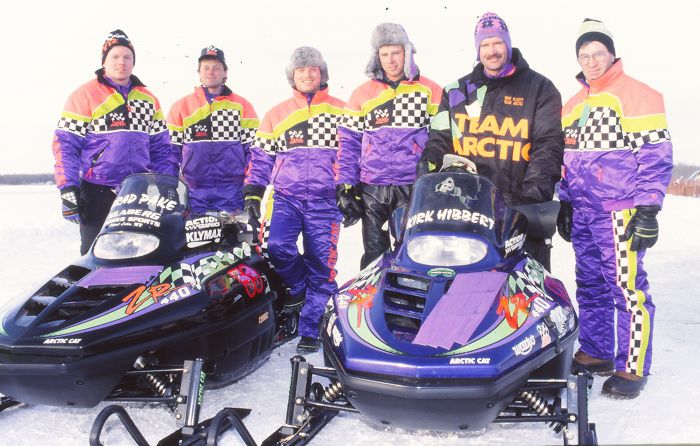
Kirk Hibbert and Pake finished 1-2 at the 1994-95 ISOC XC season opener in Pine Lake. After the finish they posed with their mechanics and crew, L-to-R: Pake, Tom Herfindahl, Jeff Lane, Mike Kloety, Hibbert, Roger Skime.
AI: You had an interesting relationship with Kirk Hibbert, where you two were often racing against each other for the win, yet you were also good friends who shared set-up info. Talk about that.
Pake: From the very beginning of my time on Arctic Cat, Kirk helped me out. He gave me suspension and set-up info. And he was really nice about it. Kirk was always trying different stuff and he’d tell me what that was. I’d ask him a lot of questions and he always had answers. Mostly things like shock valving.
We did a lot of testing against each other, and that helped both of us. Plus we were both farmers, so we had that connection.
AI: He handed you the ’96 I-500 win…now tell me about a time or two that you handed wins to him on a silver platter?
Pake: (Laughs) Of course his win in 1993 like I mentioned earlier, which he won’t remember. I’ve talked to him about it a bunch of times, but he conveniently forgets.
I’m just glad that we were friends back when we raced together, and now when we go fishing. But here’s the thing, even when we’re fishing, he’s still in racing mode. There’s no joking around for him. And judging from how little he catches, he should stick to racing rather than fishing.
AI: I know it’s bad form to ask money questions, but I’m going to anyway. Could you make a living racing back in the 1990s?
Pake: Back then we made all our money on purses and contingency. Some of those races we could win $6,000 to $7,000. And there were a couple big ones paying $30,000. Plus we’d get free sleds and parts… Dodge sponsored us a couple years. So yeah, you could make a living back then. I thought it was a good deal. I wanted to go racing, I loved the sleds, and the team was great.
AI: Did you ever get offers from any other brands?
Pake: I did some talking with Ski-Doo one year…1997 or ‘98 I think. Of course I’m glad I didn’t switch, even though they had good sleds. I made a lot of lifelong friends at Cat, which was and is worth way more than an extra $20K for one year. I’m glad they stuck with me and I stuck with them.
I could never switch now. If my kids want to ride something else, it’s their decision. But all the things that Cat has done for me… I’m always a Cat guy.
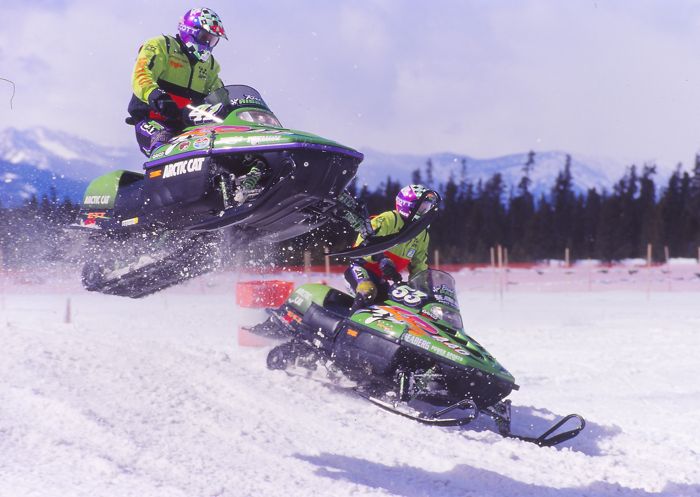
Pake (R) on his 1996 Arctic Cat ZR 440, racing against his friend (and rival) Kirk Hibbert at the West Yellowstone snocross.
AI: What’s your all-time favorite snowmobile?
Pake: The 1996 ZR440. That sled was fast, durable and consistent. It was so dependable! On it, you’re about six inches above the ground, with short track lugs. That thing cornered!
I still like the cornering of old sleds, the back end drift. You’ve got to be low to go around corners.
New sleds are made for bumps. I love the new riding position though. You have to point and shoot a little bit. But man are they comfortable!
I wonder though, if my memories are rosier than reality.
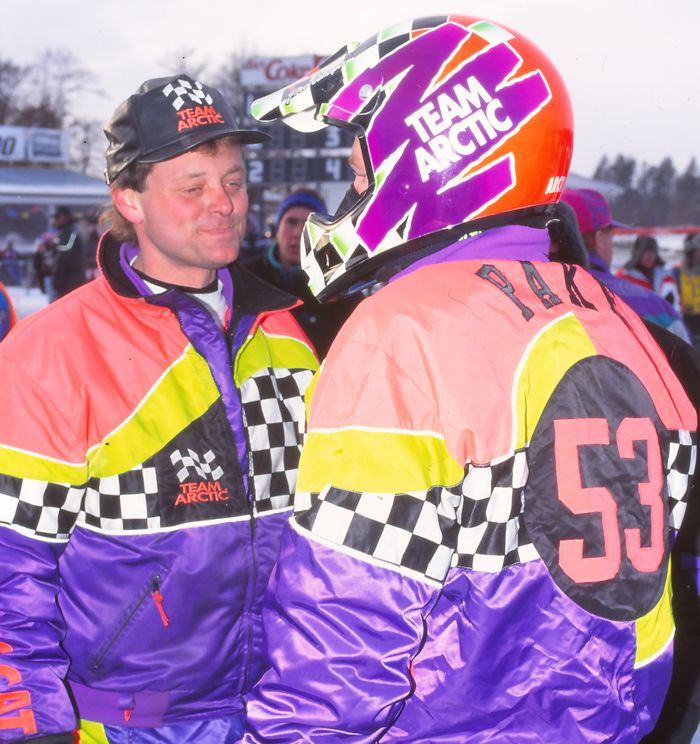
AI: Your bother-in-law, Tom Herfindahl, was your mechanic for most of your career. You guys were quite a team.
Pake: Tom was always my mechanic, as well as my friend. He did the clutching, engine and set-up work. We worked side-by-side all week long, and he was a big reason I did so well.
T/S Racing did my snocross sleds in 1997 and 1998, because it was too much for Tom and I to do them and the cross-country sleds. But Tom was always my cross-country mechanic.
We’re still good friends. We go trail riding some, and last year our families took a snowmobiling trip to Big Horns. With his sons racing cross-country and now we’re getting into it, it will be like old times.
AI: Tell me about your son Andy racing.
Pake: He’d been asking about it. I didn’t know when to start with him. We’d been riding for quite a few years. He’s now 11. He did a couple snocross races last year. This year he’s doing some snocross and cross-country.
Of course he wants to race every weekend, but I don’t know what to think. I’m not going to push him.
AI: I like that he’s going to do both snocross and cross-country. Why is that your plan?
Pake: The thing about snowmobile racing, you don’t know what the future is. Ten years from now there might not be snocross. Or it might not be the snocross we watch today. So it doesn’t make sense to commit to just one form at this young age.
It’s more fun to race in front of a bunch of people. When cross-country was big in the mid-1990s, it was big. It got way smaller the last few years I raced, so much that it felt like a local race. It wasn’t the same. It was still fun, but it wasn’t the same. The engineers weren’t there… the atmosphere was different.
If I were 20 years old, I would want to race where action was, where the commitment was. We’ll go racing where he wants to be.
If you’re going to eventually go snocrossing, you need to start there. Right now at his age, the cross-country races are actually good for preparing for snocross. I don’t like the idea of him getting landed on. You’re going to get hurt in cross-country, but it won’t be as bad [as snocross], and there’s a greater frequency of injury in snocross.
AI: You ever get the itch to race again?
Pake: Yeah, a few times a year…(pause)…Then I remember how hard it was to do full time. And it’s never as easy as it looks. Guys like Zach Herindahl make it look easier than it is. But one of these days I’m going to grab a sled and go race a cross-country, probably in Masters class. I sure liked Pine Lake this year, without snow.
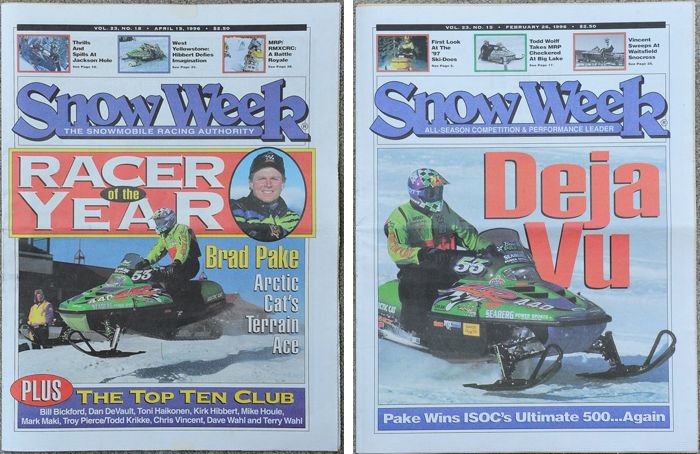
AI: How would you fare in today’s world, where you would not just race, but also promote yourself via social media?
Pake: What’s the lowest grade you can get? (Laughs)
I think social media is good, but wow is it out of control. At least in my opinion. It would drive me crazy. But that’s an old guy talking.
I miss Snow Week. For one, you were shooting for the cover. Then it had info on everything. Back then, if you did something stupid, only a few people knew about it. Now it’s all over the internet, people commentating on it.
AI: Tell me what you notice and/or think about Tucker Hibbert’s racing?
Pake: I wonder how he does it. (Laughs) I’ve watched him many times. You can think he’s out of a race, with no chance to win, and he figures out how to get in front. It’s crazy.
At Fargo this year, the whoops were 6-8 feet deep. He went through them so fast, I’d like to see slow-motion video of it because I really don’t know how he could do it. He almost never bobbles.
He’s got it all figured out. He’s the most focused racer I’ve ever seen. No distractions. I would have been messing around, but he’s totally focused.
I’m glad I never had to race him.

L-to-R: Zach Herfindahl, Hector Olson, Brad Pake and daughters Erika & Maria.
AI: How about Zach Herfindahl?
Pake: I knew he was fast. He’s the son of my wife’s second-cousin. I know his dad, Greg, pretty well. They’re a great family.
When Zach made the jump to Pro, I wasn’t sure how he’d do in longer races. Obviously he was ready. He is going to be one of the good ones. Actually, he already is. He’s 18 but races like a much more mature rider. And he has a lot more years ahead.
He loves to ride snowmobiles. You gotta be like that to be as good as he is.
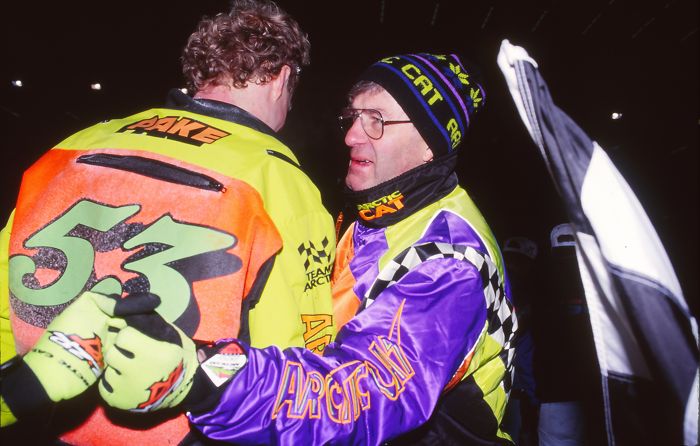
AI: Okay, let’s wrap this up with you telling a Roger story. I know you have a bunch.
Pake: Oh man, I knew you were going to ask me this. It’s so hard to tell a story that really summarizes him.
One year in November we were up in Alaska for a test trip. Kirk [Hibbert] and I had been riding a particular trail a few times, so we knew it pretty well. Which was important because there was a creek, or maybe it was a small river, that we had to cross. And it had open water.
One night we went for a ride with Roger. I don’t remember if Kirk and I were up to something, but we might have set Roger up for some difficulty on the creek crossing. After Kirk and I crossed, we turned back and… no Roger. We went back and he was neck-deep in the water with salmon swimming around him! (Laughter)
That’s just a story, but here’s the thing about Roger: He could hop in a group with some of the best racers in the world and ride the same speed. That was when he was 50.
Then he’d be in the shop, working on sleds until everyone else had gone home.
And now it’s 20 years after I first met him. We’re at Fargo a few weeks ago for the snocross, and my son Andy was on podium. It’s 10 in morning and Roger’s there, shaking Andy’s hand. Not too many guys like that. Actually, there’s nobody like Roger.
AI: That’s awesome! And it’s been great talking with you Brad. Thanks.
Pake: Thank you, it’s been fun to think about all this stuff.
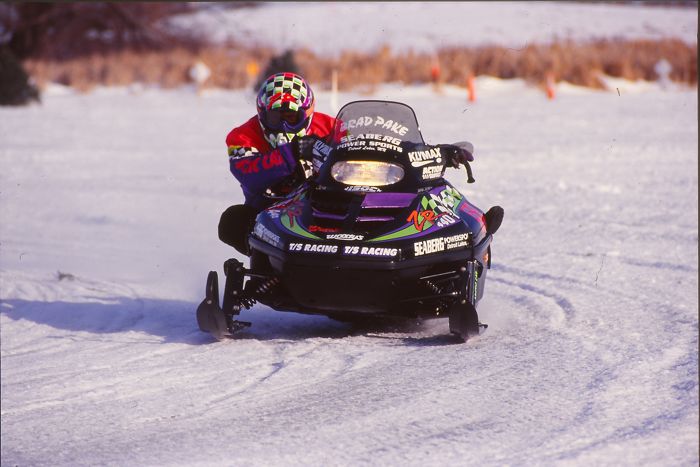
1995 was Brad Pake’s breakout season. Here he is at the ISOC Albertville cross-country.

At ISOC Garrison in 1995.

At the ISOC Brainerd BIR cross-country in ’95
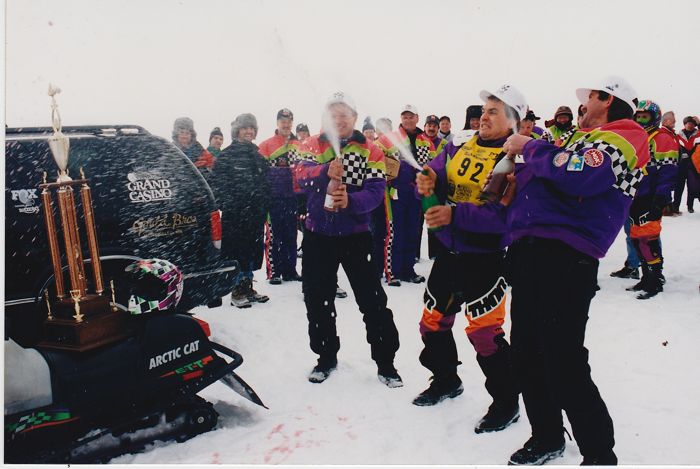
Pake’s first pro win was in the 1995 ISOC Grand 500 cross-country, where he was joined by teammates Jeremy Fyle (middle, 1989 I-500 winner) and Kirk Hibbert (right, 1990 & 1993 I-500 winner) in a 1-2-3 for Team Arctic. There was a lot of champagne flowing that evening!
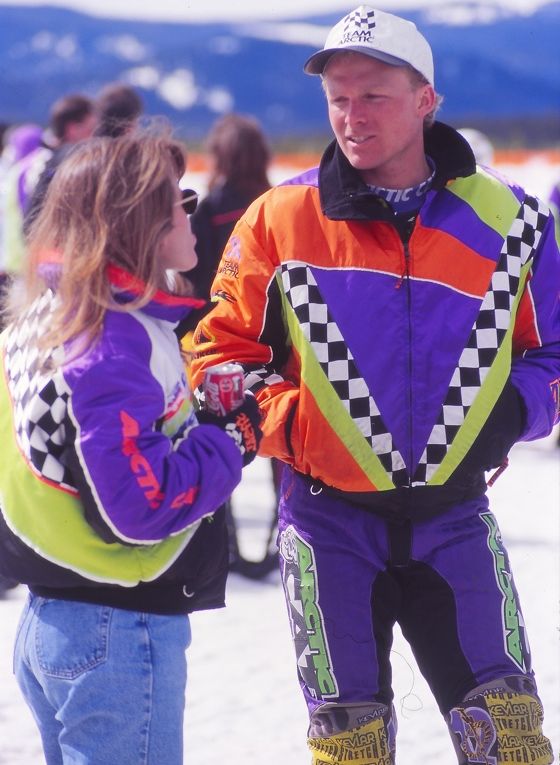
Brad and his wife Jane at the West Yellowstone snocross in 1996.

Pake opened the 1996-97 season with a win at the MRP Duluth Snocross National…
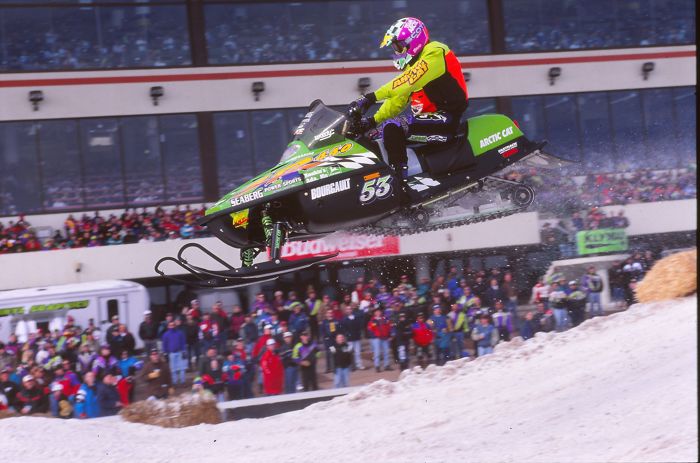
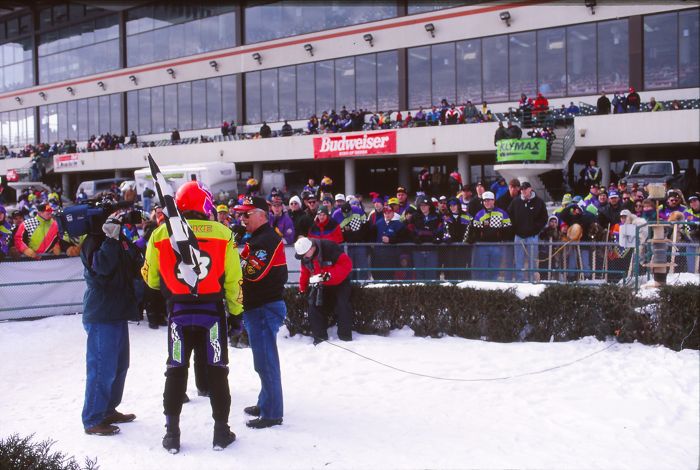
…and he followed it up with a win at Canterbury.

Later in the season, Pake tried his hand at the Eagle River World Championships of oval racing, finishing fourth in the Stock class.

In 1996 Pake scored his second consecutive win in the I-500. He raises his arms at the finish line in Roseau, Minn.

In the 1990s there wasn’t a more formidable terrain racer than Pake.
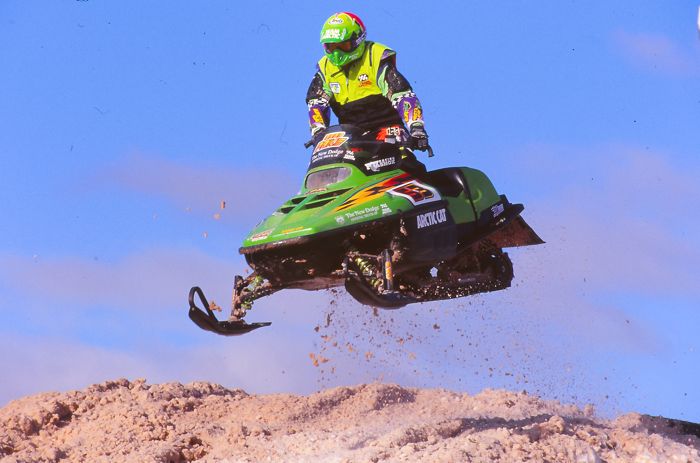

Pake scored a win at the 1997-98 Duluth Snocross National…
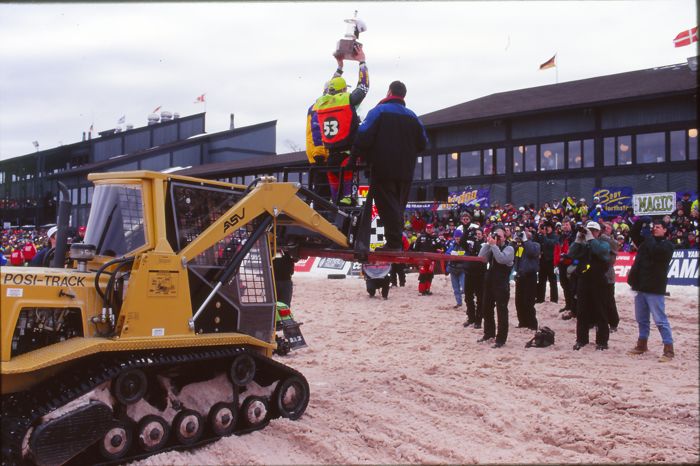
…and hoisted the trophy for the crowd and assembled journalists.
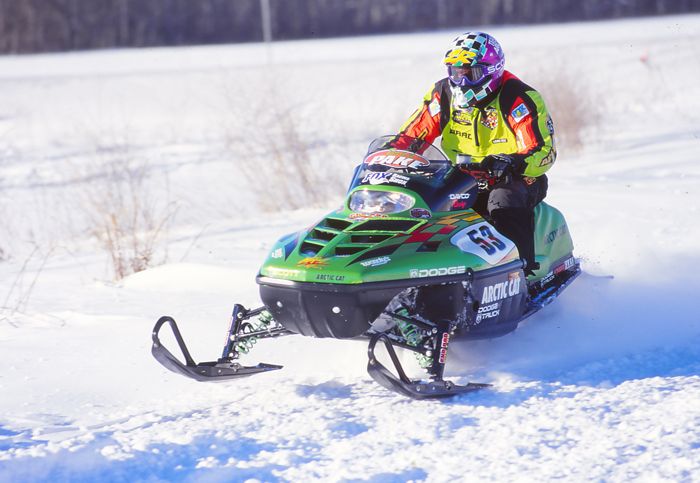
At the 1999 I-500.

The Pake family at the 2015 Canterbury snocross National. L-to-R: Erika, Brad, Andy and Maria, with Roger Skime on the far right.
Thanks for reading.


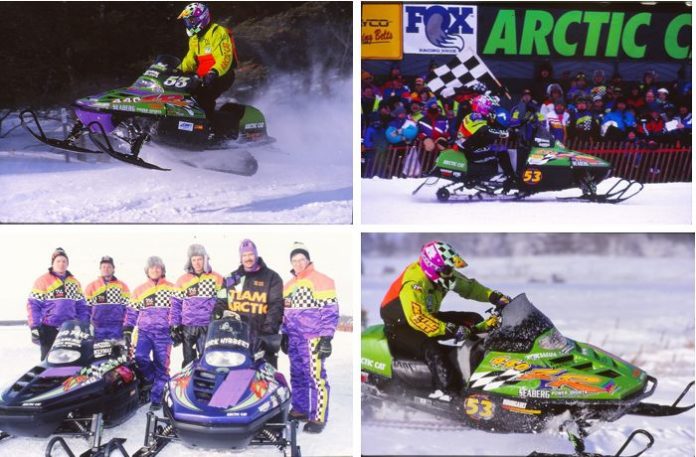
Great article! Brad was one of the most enjoyable racers I knew. He never took anything for granted. He was even-keeled (except when he got DQ’d…) and humble . Favorite memory was Canterbury when he lapped the entire field almost twice. And he’s right, there is no one like Roger Skime! …and Kirk Hibbert, for that matter. Good times!
Awesome interview! One of my all time favorite Cat racers! Brad was simply dominate when he was racing. Always one of the favorites to win at any race. Cat had a wicked arsenal of racers back in the 90’s! If, you wanted a chance to win, you better be racing a ZR.
I asked Brad at one of the Cat race schools once what the secret was to going as fast as he did down the ditches and trails. He said he kept the throttle pretty much pinned all the time and used the brake at the same time to slow down. I tried that at the next race and it worked…….for about a mile and I was airborne without my sled!! Lol …….an all around great guy.
Great article once again John!
Awesome article! Very glad I was able to be around and old enough to understand how lucky I am to be alive during this era of racing. I remember turning laps in my folks field on a poor mans ZR (97 ZL 440) and pretending to be Pake, Hibbert, Scheele, and Morgan.
Great interview! Been a huge fan of Brad since I was just a little kid. Pake and Hibbert are what got me into watching snocross. Also was a big fan of him when he was racing sprint cars in the mid 2000s. He was honestly was one of the most dynamic sprint car drivers at the time, and probably still could be. Good to see his son following in his foot steps!
PS
Brad, please buy a race car and come back to dirt track racing. You’re never too old for that.
Sincerely
The Norman County Raceway Announcer
Excellent interview! Brad Pake was my favorite racer back then, I watched him and Kirk Hibbert race for the first time at Trollhaugen ski resort, the first year of the green ZR 440’s, and promptly went out and bought a new 1997 zr 440 the next year after watching those guys dominate! Thank you for entertaining us all those years Brad, it’s innovators like you that made the sport and Arctic Cat what it is today!
Those were great times to be an XC race fan. Mr.Pake is right up there as one of the VERY best terrain racers ever. Great interview!
I remember going over to the race shop and getting a couple of hats signed by Brad and Kirk. Man, those were the biggest names at the time. I wonder if my brothers still have those hats…
BTW, the ASV MD-70 is really fitting for an Arctic Cat article. Its all in the family.
Todd
I can still remember the DQ due to the porting in the cylinders. We were ticked off something fierce, not to mention Roger. Suzuki seemed to be known for building things at the low end of the tolerance. There were a few times when we’d dyno a ‘Shark engine, make our mods for Suzuki, and then send it off to them. What we’d get back was 5-10 HP less than had originally built, but it was in specs per Suzuki.
The 1990’s were indeed a great time to be a fan of Team Arctic, just as it is today…I love it when history repeats itself! Great reading here, thanks for sharing Brad/John.
Thank you Brad for sharing your racing days with John. Great article John, great photo’s ! still have my 97 ZR440, runs great, couldn’t wait for my issue of Snow Week to follow Brad and Kirk’s success.
Fantastic article ! It is great to see all of the race photos of those 96 and 97 ZR’s dominating the tracks back then. It almost isn’t fair that they can STILL dominate classic IFS and out corner anything on snow to this day. My 18 year old! (wow) 97 ZR still leaves any new sled’s rider scratching their head on a fast twisty trail here in Wisconsin. Brad, your memory’s right on!!!!
Great story john
man. what an interesting article. i never knew brad did that much racing. excellent pictures too. ugh, polaris….do you feel stupid yet? how ’bout now?
John Sandberg, great full body story and fantastic photos from the second big era of XC racing. Brad Pake, you are a class act. Racing is about the action, the people and the memories. Thank you.
Interesting that most of the great snowmobile racers over the years were farmers or at least grew up on a farm. Reminds me of my high school wrestling days when almost everyone on the team was a farm boy. Yep! Nothing like throwing hay bales and pitching s–t to make a guy rough and tough!
I have the pleasure of having Brad and his dad Don as customers of mine, can’t say enough nice things about them they are both class act people. My welder used to race quads with Brad and used to tell us story’s of how he would lap the field then too ! One quick story from a former female cross country racer she told of a story during a race when the fog and snow dust were so bad she could hardly see, then says ” then here comes Brad Pake by me like I was standing still ” . Sounds like Brad ! Great story John thank you for the interview and thanks Brad for sitting long enough to do it !
Awesome story John. I too remember his great battles when he was racing. I too had a ’97 ZR 440, them sleds were fast and agile. These sleds were the best sleds Cat ever built for racing and trail riding. I raced my ZR in the open class cross countries, and I past alot of 600 and some 700cc sleds.
Great story. Brad is class act, when we were helping Bryan Dyrdahl in 2000, Bryan was ask who’s the the guy to beat, he answered without hesitation Brads the best,(quite a testamate from a 5 time I-500 winner) Also what was not mentioned, was that Brad teamed up with Brian Sturgeon to win the cat 300 endure race Also, He won at crosscountry, snowcross, hillclimbs, endure, and was competitive in ovals in a small sample. I’ve never seen another racer that was that good at so many disciplines. Should be in the racers hall of fame.
The good ol days of ISOC!
If my memory serves me correctly Tom Lawrence worked for AC and was the Tech Director work ISOC the yesr Brad was DQ’ed in the Ironman
Brad is a legend of all! He’s been very successful in everything he’s raced! I watched him in mods, sprints & snowmobiles, & has the talent to race them all! Another man people have forgot about who reminds me of Brad Is a great friend of mine Bryan Dyrdahl! I put both them in the same category! Both have awesome talent for anything they race!!! I believe both deserve sum hall of games! Great memories!!!??